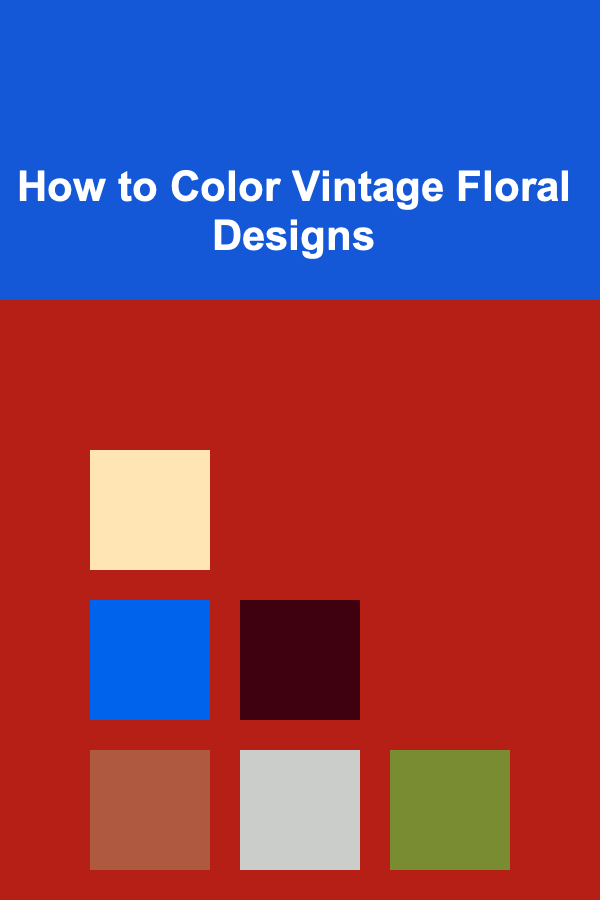
How to Color Vintage Floral Designs
ebook include PDF & Audio bundle (Micro Guide)
$12.99$5.99
Limited Time Offer! Order within the next:

Vintage floral designs are beloved for their intricate patterns, rich history, and nostalgic appeal. These designs, whether they originate from the Art Nouveau period, Victorian era, or the early 20th century, continue to captivate modern audiences. Coloring these vintage floral patterns is an art in itself---a way to bring new life to old creations. Whether you're a beginner or an experienced artist, coloring vintage florals requires a careful balance of respecting the original design while allowing your personal creativity to shine.
In this guide, we will explore the techniques, color palettes, and approaches to help you effectively color vintage floral designs. From understanding the history behind the patterns to experimenting with modern techniques, this article will provide comprehensive insights to master the art of coloring vintage florals.
Understanding Vintage Floral Design Styles
Before you dive into coloring, it's essential to familiarize yourself with the various vintage floral design styles. Different historical periods favored particular design elements, color schemes, and motifs, and understanding these can help you maintain an authentic feel when coloring.
Victorian Floral Designs (1837-1901)
The Victorian era was marked by opulence, detailed craftsmanship, and a love for nature. Floral motifs during this time were often elaborate and highly detailed, inspired by lush gardens, wildflowers, and botanical prints. Flowers such as roses, lilies, and peonies were popular choices, often intertwined with vines and delicate leaves.
- Key Characteristics: Intricate detailing, dark and rich colors, and an emphasis on texture.
- Color Palette: Deep reds, purples, greens, golds, and soft pastels. Use darker shades for depth and light hues for highlights.
Art Nouveau Floral Designs (1890-1910)
Art Nouveau was a movement that celebrated the beauty of nature, often merging organic forms with flowing, sinuous lines. Floral designs from this era were highly stylized, with curved shapes and elongated petals. Flowers like irises, orchids, and poppies were popular, and there was an emphasis on symmetry and harmony.
- Key Characteristics: Flowing lines, stylized flowers, and organic patterns.
- Color Palette: Muted tones, such as soft blues, greens, and browns, mixed with highlights of gold or deep purple. Pastel tones are frequently used in the petals, while earthy greens work well for the leaves.
Art Deco Floral Designs (1920s-1930s)
Art Deco brought a more geometric and symmetrical approach to floral designs. While still inspired by nature, floral elements in Art Deco designs were often simplified and stylized to fit a more modern and clean aesthetic. The use of bold lines, contrasting shapes, and a more abstract representation of flowers was common.
- Key Characteristics: Geometric patterns, streamlined shapes, and stylized floral representations.
- Color Palette: Bold contrasts such as black, white, gold, silver, and jewel tones like emerald green, ruby red, and sapphire blue.
Mid-Century Modern Floral Designs (1940s-1960s)
During the mid-20th century, floral designs became more minimalist, often relying on vibrant, flat colors and abstract interpretations of flowers. This period also embraced the use of bold patterns and new printing technologies, making floral designs appear both graphic and playful.
- Key Characteristics: Simplified shapes, bold use of colors, and abstract floral motifs.
- Color Palette: Bright and vibrant colors like turquoise, mustard yellow, coral, and red. You might also see earthy tones like avocado green and mustard in some designs.
Understanding these styles can serve as inspiration for selecting your color palette and applying appropriate techniques for each type of design.
Selecting the Right Color Palette
The color palette you choose will greatly influence the mood and depth of your vintage floral designs. While it's tempting to experiment with all colors available, selecting a thoughtful palette will help you maintain harmony and bring out the best features of the design.
Tips for Choosing a Color Palette:
- Match the Era: As discussed, different vintage styles lean towards specific color schemes. For instance, Victorian florals may look best with rich, deep tones, while Art Nouveau designs work well with muted pastels and organic hues.
- Consider the Background: Some vintage floral designs feature textured or ornate backgrounds. If the background is complex, opt for a more subdued color palette for the flowers to ensure the overall design doesn't become overwhelming.
- Use Contrast and Harmony: Combine contrasting colors (such as complementary colors) to make certain floral elements pop, while using analogous colors for smoother transitions and cohesive looks.
- Warm and Cool Colors: Balance warm colors (reds, yellows, oranges) with cool tones (blues, greens, purples) to create dynamic compositions. Mixing warm and cool hues can help bring depth and dimension to the design.
Recommended Color Palettes:
- Soft Pastels for a Romantic Look: Lavender, blush pink, soft peach, mint green, and ivory.
- Bold and Vibrant for Energy: Royal blue, bright red, sunny yellow, emerald green, and deep purple.
- Earthy Tones for Vintage Charm: Rust orange, olive green, mustard yellow, and brown.
- Monochrome for Simplicity: Using varying shades of one color, like different blues or purples, can create a more cohesive, minimalist aesthetic.
Techniques for Coloring Vintage Florals
Once you've selected your color palette, it's time to start applying color to your vintage floral design. The technique you use can dramatically alter the final result. Here are some coloring methods that work well with vintage floral patterns.
3.1. Layering and Blending
Layering and blending are two essential techniques for creating depth and dimension in your floral design. By layering colors and blending them softly, you can create smooth transitions between petals, leaves, and other floral elements. This technique is particularly effective for flowers like roses, where you need a gradual transition from one shade to another.
How to Layer and Blend:
- Start with light colors for the base of the flower or leaf.
- Gradually build up darker shades to add depth and dimension.
- Use a blending tool (such as a soft brush, blending stump, or your fingers) to blend the layers seamlessly together.
- Continue adding layers, building up from light to dark until you achieve the desired level of richness.
3.2. Cross-Hatching and Stippling
For more intricate floral designs, techniques like cross-hatching or stippling can be used to add texture and shading. These methods work particularly well for vintage designs with lots of detailed linework or engravings. You can use fine-tipped pens, colored pencils, or even digital tools to achieve these effects.
- Cross-hatching: Use overlapping lines in different directions to create depth, shading, and texture.
- Stippling: Add texture by using tiny dots to build up shadows and gradients.
Both methods are great for giving your floral design a vintage, hand-drawn appearance.
3.3. Watercolor Techniques
Watercolor techniques are ideal for vintage floral designs, as they offer a soft, ethereal quality to the overall composition. Watercolor can also mimic the delicate, flowing nature of flowers seen in vintage patterns.
How to Use Watercolor:
- Apply a light wash of color to the areas you want to appear softer.
- Build up layers of color, allowing each layer to dry before adding the next.
- Use water to create smooth transitions between colors or to lighten certain areas.
- Add darker accents around the edges of flowers or leaves to give them definition.
Watercolors are particularly useful for designs from the Art Nouveau period, where flowing, organic lines are common.
3.4. Using Digital Tools for Color
If you're working digitally, you have access to a wide range of tools that can speed up the coloring process while still producing high-quality results. Digital programs like Adobe Illustrator or Procreate allow you to experiment with color palettes and textures without worrying about smudging or erasing.
Tips for Digital Coloring:
- Use layers to separate the different elements of your design, such as flowers, leaves, and backgrounds.
- Take advantage of gradient tools to smoothly blend colors.
- Use texture brushes to add depth and interest to petals and leaves.
- Experiment with opacity and transparency to create a sense of light and shadow.
Digital tools also allow you to easily adjust the colors later on, giving you more flexibility to fine-tune your design.
Adding Final Touches and Refinements
Once you've filled in the basic colors and shades, it's time to refine your design. This involves adding final details and highlights that will make the flowers come to life.
Refining Techniques:
- Highlights: Use lighter colors or a white gel pen to add highlights to areas that catch the light. This will give the flowers a fresh, dewy look.
- Shading: Add subtle shadows with darker colors to give your flowers depth and make them appear three-dimensional.
- Texture: Enhance the texture of petals and leaves by adding veins, wrinkles, or other fine details that mimic the natural appearance of flowers.
Conclusion
Coloring vintage floral designs is an enriching and creative process that allows you to connect with the past while adding your personal touch to timeless motifs. By understanding the different historical styles, selecting a thoughtful color palette, and applying various techniques, you can transform any floral design into a stunning work of art. Whether you're working with traditional media or digital tools, these tips will help you enhance your skills and create beautiful, vibrant floral pieces.
The most important aspect of coloring vintage floral designs is to enjoy the process. Let each petal, leaf, and bloom guide you through the journey, and remember, there's no one right way to bring these designs to life.
Reading More From Our Other Websites
- [Home Soundproofing 101] How to Soundproof Your Home Theater with Acoustic Tiles
- [Home Renovating 101] How to Balance Open and Closed Spaces in Design
- [Organization Tip 101] How to Organize Your Child's Playroom for Fun and Function
- [Organization Tip 101] How to Create a Side Hustle Budget for Extra Income
- [Home Cleaning 101] How to Keep Your Home Clean with a Busy Schedule
- [Gardening 101] How to Choose the Best Garden Hose for Your Needs
- [Organization Tip 101] How to Select the Best Organizers for Your Office Drawers
- [Stamp Making Tip 101] How to Manufacture Custom Self‑Inking Stamps for Craft Fairs
- [Home Staging 101] How to Understand the Difference: Home Staging vs. Interior Design for Selling Your Property
- [Home Family Activity 101] How to Build a DIY Family Tree with Your Kids

How to Build a Checklist for Holiday Tree Decorating
Read More
How to Sell Vintage Designer Handbags on Online Fashion Platforms: An Actionable Guide
Read More
The Art of Data Engineering: Crafting Intelligent Solutions from Raw Data
Read More
How to Build a Fire Pit in Your Backyard
Read More
Mindfulness for Personal Growth: A Comprehensive Guide
Read More
How to Design a Nighttime Routine for Productivity
Read MoreOther Products

How to Build a Checklist for Holiday Tree Decorating
Read More
How to Sell Vintage Designer Handbags on Online Fashion Platforms: An Actionable Guide
Read More
The Art of Data Engineering: Crafting Intelligent Solutions from Raw Data
Read More
How to Build a Fire Pit in Your Backyard
Read More
Mindfulness for Personal Growth: A Comprehensive Guide
Read More